If you buy through our links, we may earn an affiliate commission. This supports our mission to get more people active and outside.Learn about Outside Online's affiliate link policy
Ask A Gear Guru: Should I Wear A Sleeved or Sleeveless Triathlon Wetsuit?
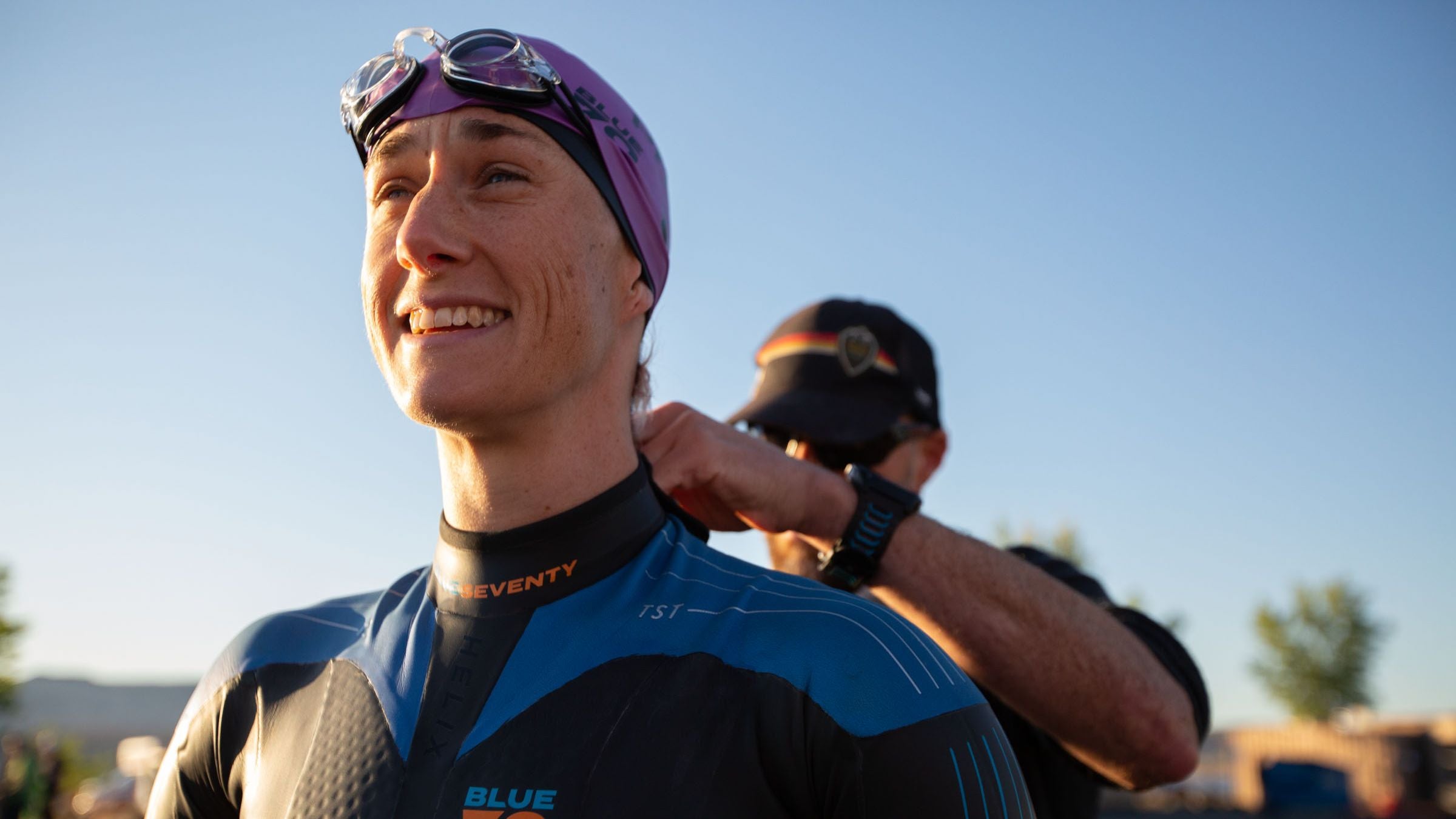
(Photo: Brad Kaminski)
Wetsuits come in two major categories: full-sleeve and sleeveless. A full-sleeve triathlon wetsuit has neoprene sleeves that come all the way to the wrist, while a sleeveless triathlon wetsuit stops at the shoulders like a tank top. Both styles have full legs and a rear zipper and are very similar in all other aspects. Determining which style of suit is best for most triathletes might not be a clear-cut answer. And sometimes, owning one of each kind is a really (really) good idea.
Pros of Full-Sleeve Triathlon Wetsuits
The basic benefits of a full-sleeved triathlon wetsuit are additional warmth, added floatation, increased hydrodynamics, and protection from the elements.
More heat is retained when wearing a suit that covers more body surface. By limiting the amount of cold water flowing over the skin, body heat is stored inside the suit. Removing sleeves—particularly in the armpit area, where much of your heat can be stored or lost—can make a big difference in core temperature, for better or for worse. Also, the small amount of water that enters the suit through the neck hole is warmed up by the body and provides a more comfortable experience in chilly water.
The additional neoprene of the sleeves also provide additional lift and flotation in the water. Even though the sleeves are typically made from a thinner and more flexible layer of neoprene, they still provide buoyancy to the arms and upper body.
A full-sleeve triathlon wetsuit also gives the wearer a sleeker profile through the water. Just like how Olympic swimmers wear skin-tight suits or how Spanks smooth all the wrinkles out, the wetsuit sleeves keep the wearer’s arms silky and streamlined with less resistance and more speed through the water. The full sleeves also provide additional protection against the elements. Some ocean swims are infamous for jellyfish, sea lice, or other uncomfortable sea life. With a bike and run to follow, protecting as much skin as possible from unwanted stings and irritations can be a smart advantage.
RELATED: The Best Triathlon Wetsuits of 2024
Pros of Sleeveless Triathlon Wetsuits
A sleeveless wetsuit also has numerous benefits including less insulation, a better fit, and less constriction for most triathletes.
The wetsuit legal cut off temperature for triathlons in the USA is 78 degrees F (or 25.5 degrees C) which can be quite warm on a hot summer day. Athletes can prevent overheating in the water by choosing a sleeveless wetsuit for higher temperature waters while still getting the flotation and speed benefits provided by the rest of the suit. Instead of holding in body heat, the open arms are able to allow the wearer to cool off and better regulate body temperature without sleeves and exposed armpits.
Sleeveless wetsuits are also typically a better choice for triathletes with large upper bodies. This includes any athlete with heavily muscled shoulders and arms who would struggle to fit and function in tight sleeves. Maintaining maximum shoulder range of motion is a high priority when trying to swim fast, and no matter how flexible the neoprene in a full suit, it’ll still be more restrictive than nothing at all. Plus: Triathletes with large chests can have difficulty breathing in a full suit due to torso constriction, and a sleeveless suit gives more freedom to fit, breathe, and move during the swim.
RELATED: The Best Sleeveless Wetsuits for Triathlon
What Type of Triathlon Wetsuit Should I Choose?
Consider these five questions when choosing between a sleeveless or full-sleeved triathlon wetsuit:
- What types of swim conditions am I expecting at my races?
- What is my body shape?
- Is my priority speed or comfort?
- What is my budget?
Today, there are sleeveless or full-sleeved tri wetsuits to match any budget. The higher priced suits will include more technology designed for speed like higher flexible neoprene, fewer seams to cause chafing, neutralized buoyancy, etc. Typically, sleeveless wetsuits are produced in line with the mid and low-range full-sleeved suits. The higher range wetsuits are only produced with full sleeves because the primary focus is speed.
RELATED: What Matters (And What Doesn’t) When Buying a Wetsuit
Get One of Each
Owning one of each wetsuit is a smart decision for the invested triathlete. Make a big purchase on a well-fitting and high-quality full-sleeved wetsuit and keep it safe for the major races or key race-day simulation training sessions. Then, purchase a mid- to low-level sleeveless wetsuit to use for weekly training purposes like pool training sessions, low-priority races, transition practice, summer open-water swims, vacation swims, and more.
Choosing to wear a sleeveless or full-sleeved wetsuit is not a one-size-fits-all answer for every triathlete. Don’t choose to wear a particular wetsuit just because someone you know or a pro triathlete you admire has made that same selection. Give an honest answer to the questions above, consider all your race-day conditions, and choose the wetsuit that will give you the best results.
Below we’ve collected two of our favorite sleeveless wetsuits and two of our favorite sleeved triathlon wetsuits, but be sure to check out our big yearly wetsuit guide for full reviews on more great choices
Our Favorite Sleeved Triathlon Wetsuits
Orca Athlex Float
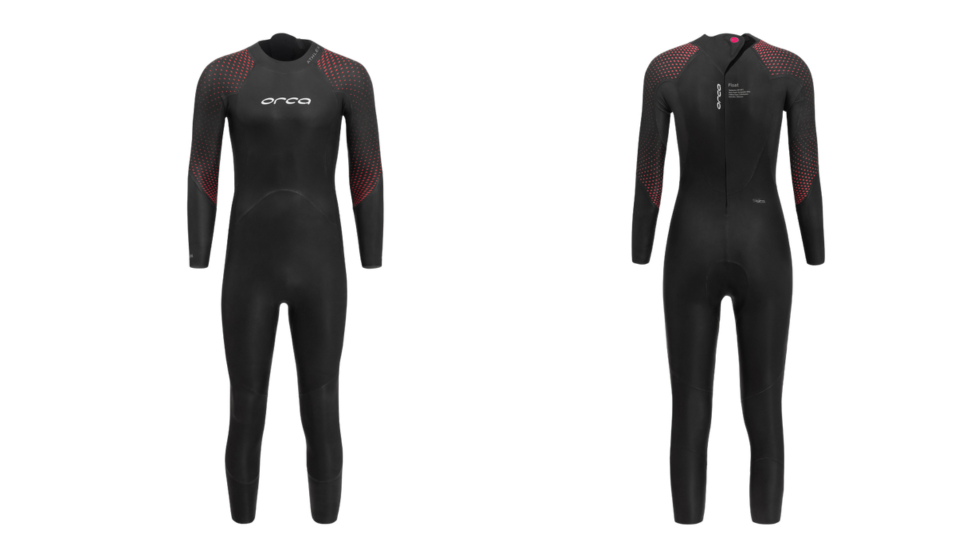
Truth in advertising: The Athlex Float will make you float – a lot. This super-buoyant wetsuit can correct even the heaviest of legs, thanks to 4.5mm neoprene in the lower half of the suit that tapers to a thinner, more elastic material in the upper body. Small details make it clear the designers of the suit are open-water swimmers themselves: a laser-cut neck lays low and flat along the skin, yet no excess water comes in, and a small neoprene pocket along the zipper is explicitly designed to hold your keys, so you can stop worrying about leaving them on the beach during open-water practice.
Though the women’s suit is actually designed for the contours of a woman’s body, some of the details can be dialed in a bit more – the legs feel loose, while the wrist openings are very tight. The women’s suit design also seems to cater to those with short torsos, with “tall” options only for sizes XS and S. Size up or consider the mens’ version if tall or have a longer torso.
– Susan Lacke, Senior Editor
Zone3 Terraprene Vision
$280, us.zone3.com
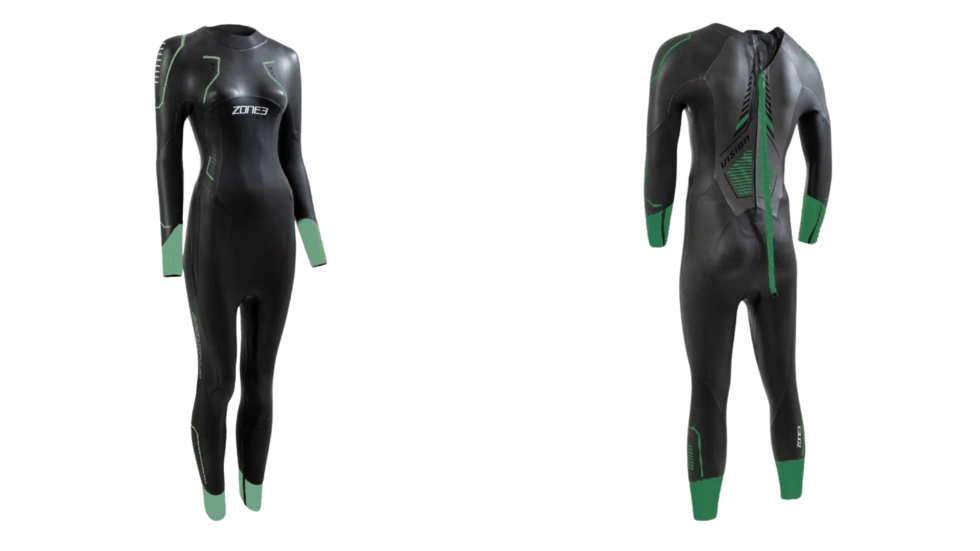
Zone3 caters to the sustainability-minded triathlete with Terrapene, a synthetic rubber that is 100% biodegradable. The material, developed by the same specialists who developed the oft-used Yamamoto neoprene, will break down fully in a compostable environment but is designed to not decompose during normal swimming or storage.
But this is no greenwashing stunt – the Terraprene Vision is a legit performance suit, with suppleness and flexibility throughout. That means easy on, easy off, and plenty of movement in the places you want to move. The suit feels light and unrestrictive, especially in the shoulders, thanks to a one-piece 1.5mm shoulder panel design that nails the ideal “second-skin” fit swimmers desire; 3mm panels on the torso and the front of the legs provide buoyancy without creating an excessive feeling of “swimming downhill.” I also appreciated the thinner 2mm cuffs at the wrists and ankles for ease of removal, though I would have liked to see slightly longer sleeves, as these hit closer to my elbow than my wrist.
-S.L.
Our Favorite Sleeveless Suits
Synergy Hybrid EFX3 Sleeveless
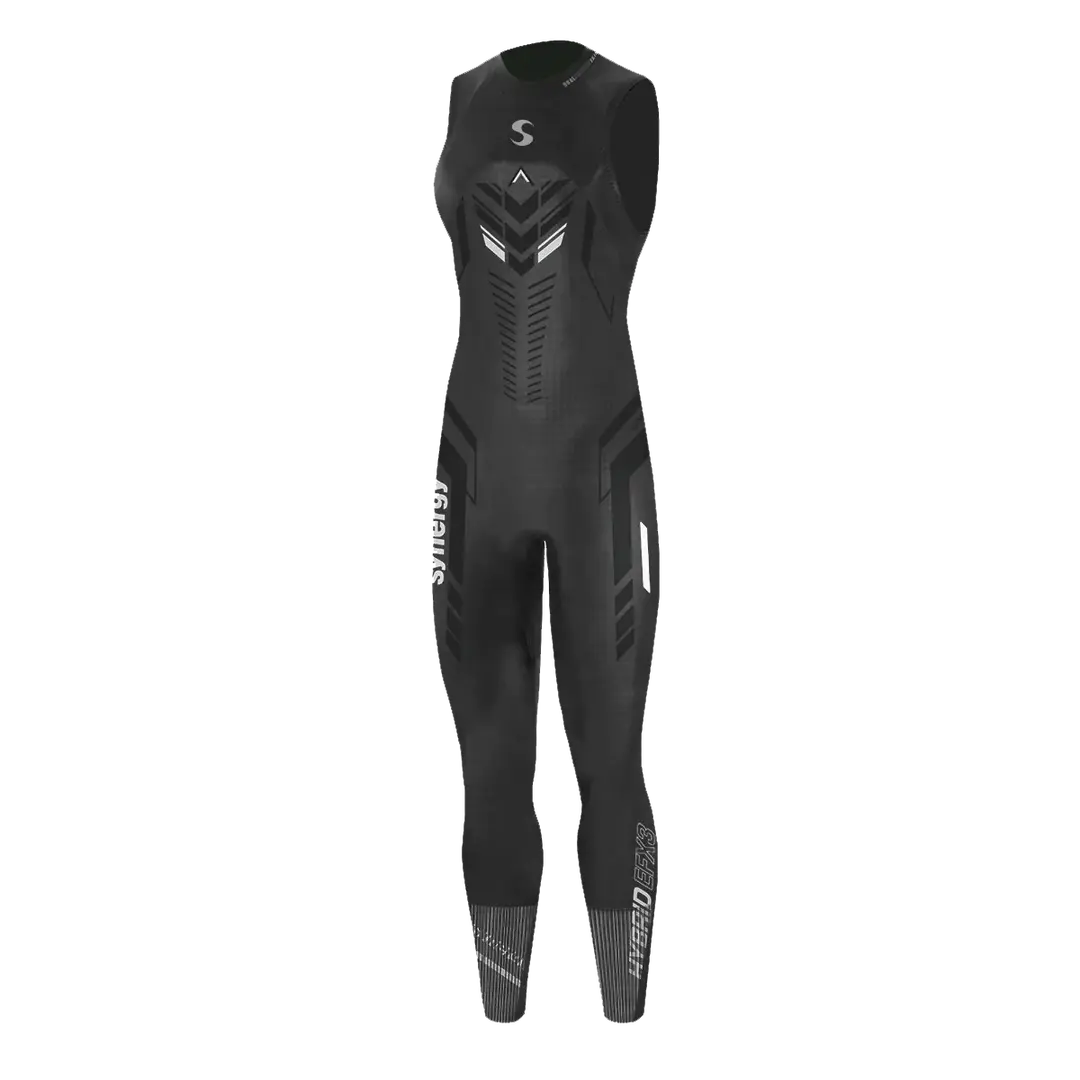
In our extensive sleeveless wetsuit roundup, the HYBRID EFX3 was the only suit to receive five stars from our testers—and there’s a reason for that. Rather than costing an arm and a leg, this sleeveless version of Synergy’s ultra-premium suit ticks all of the boxes of a $500+ wetsuit, but is a better solution than most for warmer swims, triathletes with larger upper bodies, or swimmers who simply want zero shoulder restriction when they swim. Our testers noted a super-important “thin and soft 2mm hiflex neoprene” as a huge asset to being secure but gentle around the neckline—huge for sleeveless suits. Our testers also loved the minimal cut around the arm holes to give upper back protection, warmth, floatation, and hydrodynamics.
BlueSeventy Sleeveless Reaction
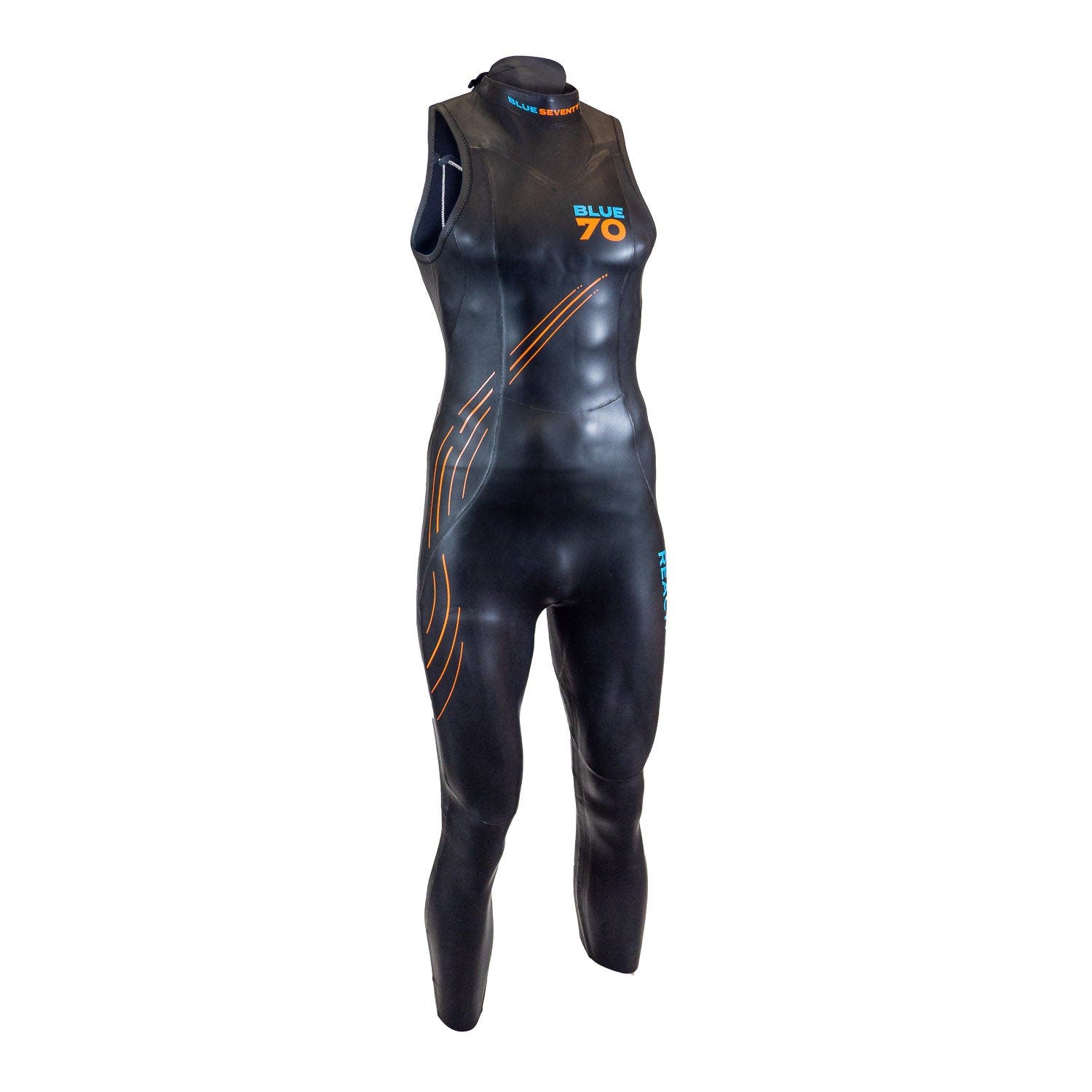
Coming in a close second to the Synergy suit, BlueSeventy’s Sleeveless Reaction is the result of a newly redesigned Reaction template for less than half the price of its sleeved sibling. Multiple panels across the upper and lower body meant a tighter fit with less chance for leakage or chafing. The only downside to the Sleeveless Reaction’s premium neoprene is how delicate it is for anyone looking for a second training suit to toss around or keep in the car, but the other side of that coin is that the delicate neoprene feels super supple and flexible.
RELATED: Ask A Gear Guru: How In The #$*& Do I Put On A Triathlon Wetsuit?